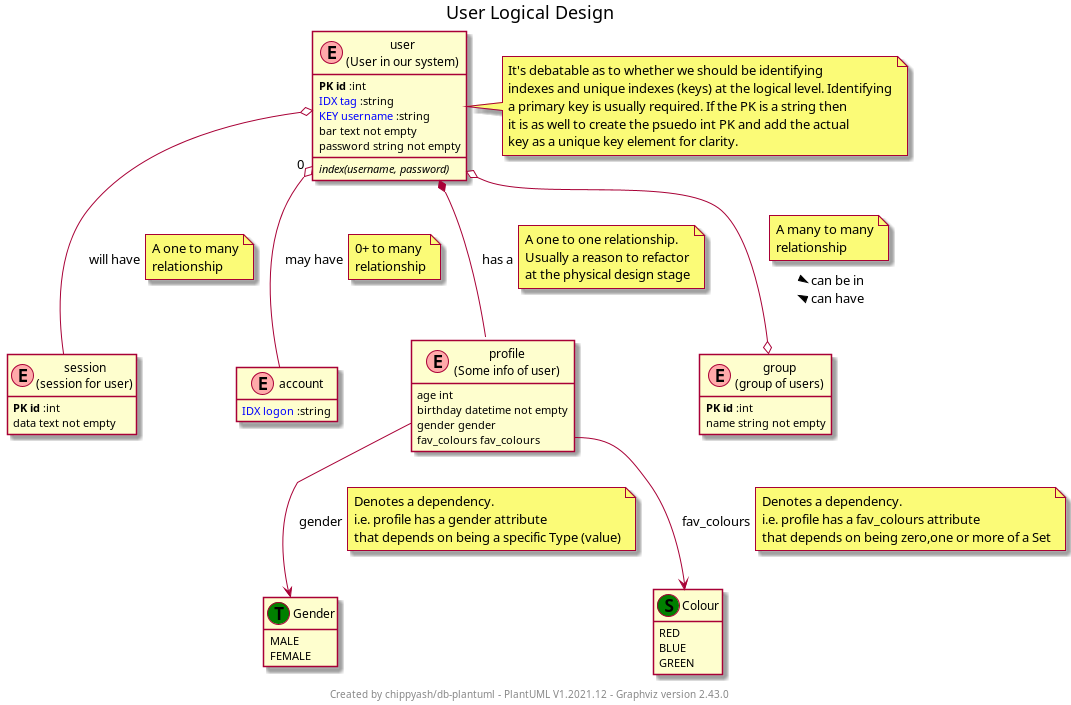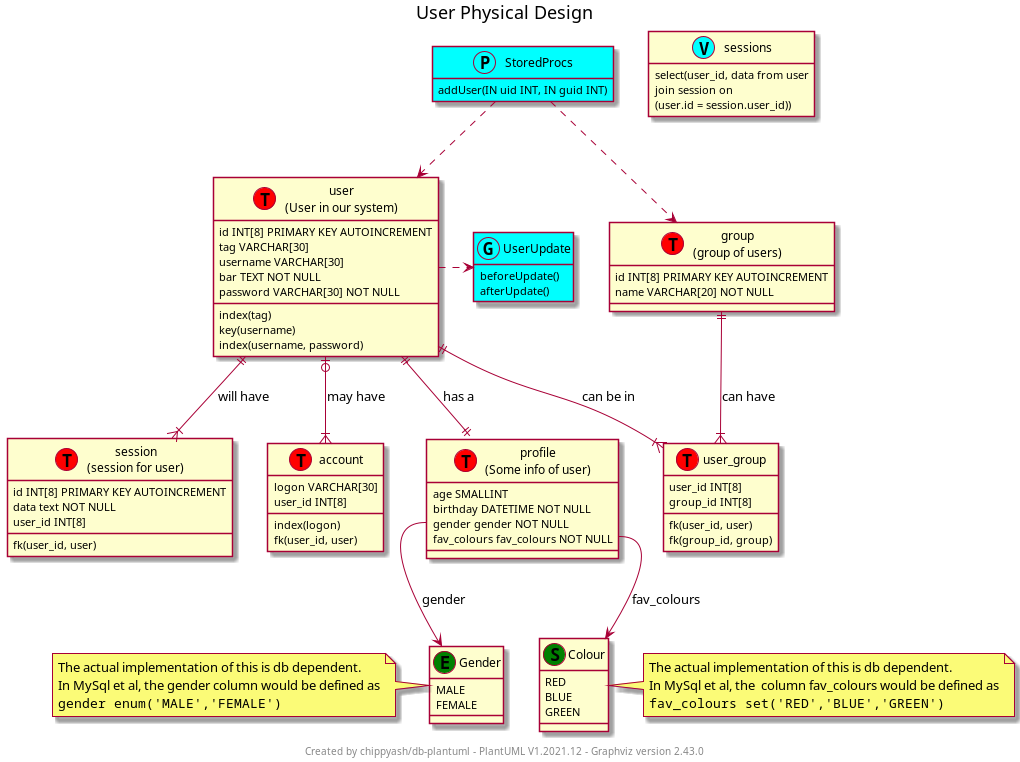chippyash / db-plantuml
Support for creating DB logical and physical diagrams using the awesome PlantUml
Installs: 4
Dependents: 0
Suggesters: 0
Security: 0
Stars: 20
Watchers: 1
Forks: 2
Open Issues: 1
Type:project
pkg:composer/chippyash/db-plantuml
Requires
- php: ^8.0
- ext-dom: *
- ext-xsl: *
- symfony/console: ^5.0
Requires (Dev)
- mikey179/vfsstream: ^1.6
- phpunit/phpunit: ^8.5
README
chippyash/db-plantuml
What
- Provides Plantuml !include files that you can use to create logical and physical database diagrams
- Provides a (PHP) utility to turn the diagrams into DDL files to create your database.
PlantUml Support
- Tested with PlantUML V1.2021.12 - Graphviz version 2.43.0
2 definition files
- DatabaseLogical.iuml
- DatabasePhysical.iuml
Goal
To quickly create logical db designs that end users might understand and convert them to initial physical designs with additional functionality that can be turned into something developers will understand, i.e. a SQL Schema
Demo
- Open
examples\User-Logical.pumland display the drawing - Open
examples\User-Physical.pumland display the drawing
Look at both files. The only difference between them is
- a/ the included file defined at top of definition
- b/ physical drawing has additional features
- View
- Trigger & trigger()
- (Stored) Proc and uses()
The original logical definition was copy-pasta'd from the logical file to the physical file and renders automatically in physical form.
Take a look at the dist\*.iuml files. It's the subtle differences between the
function declations that allows the transform to happen.
Installation
There is no real need to install this code base. You can access the
required files remotely using the !includeurl directive.
You do however, need to install PlantUml!
Usage
- Create your logical model to represent customer/user view
- Copy logical model file to physical model file and change the !include statement. Amend as necessary.
- (Optional) Generate the SQL DDL file to create your database
Logical Models
!include ../dist/DatabaseLogical.iuml
or
!includeurl https://raw.githubusercontent.com/chippyash/db-plantuml/master/dist/DatabaseLogical.iuml
 Logical model will display the following differently to their representation
in a Physical model
Logical model will display the following differently to their representation
in a Physical model
Components
Table(alias, name="", description="") //preferred
or
Entity(alias, name="", description="") //psuedonym for Table
Type(alias, name="", description="") //data type (enum)
Set(alias, name="", description="") //data type (set)
Data types
string(l=30)
char(l=12)
text()
date()
time()
datetime()
int(l=8)
real()
bool()
NB string and int lengths do not display in logical models, but specify them if you know them as they will be displayed in physical models.
You can display other data types directly in your entity classes e.g.
Table(t1, foo) {
bin_data blob
}
Type modifiers
not_null(name, type)
unsigned(name, l=8) //unsigned integer with a name
_unsigned(l=8) //unsigned integer, use with primary() etc
Indexes and keys
primary(name = 'id', type=_unsigned(8), auto=1) //primary key
idx(name, type=int()) //non unique index - one member
idx2(name1, name2) //non unique index - two members
idx3(name1, name2, name3) //non unique index - three members
Relationships
zeromany(from, to, verb, tNum='n')
onemany(from, to, verb, tNum='n')
manymany(from, to, verbFrom, verbTo)
oneone(from, to, verb, keyname='id', type=int())
depends(from, to, colname) //enum and set dependencies
There is an internal relationship _join
_join(from, to, verb, fNum, tNum)
e.g.
_join(a, b, has, 0, n)
You can use this to fine tune relationships as required. fNum & tNum accept an integer or 'n'.
Physicals Models
!include ../dist/DatabasePhysical.iuml
or
!includeurl https://raw.githubusercontent.com/chippyash/db-plantuml/master/dist/DatabasePhysical.iuml
Use the same statements as per Logical models. In addition there are:
Components
Trigger(alias, name)
e.g.
Trigger(t1, UserUpdate) {
beforeUpdate()
afterUpdate()
beforeInsert()
afterInsert()
beforeDelete()
afterDelete()
}
Proc(alias, name)
e.g.
Proc(p1, StoredProcs) {
addUser(uid, guid)
}
View(alias, name)
e.g.
View(v1, sessions) {
select(user_id, data\nfrom user, session\njoin id on user_id)
}
Indexes and keys
foreign_key(tableName, to, type=int(), suffix='_id')
Foreign keys are automatically generated where appropriate between Tables in your model. You may need to explicitly declare them for Tables that are off model.
Relationships
function triggers(from, to) //table actions trigger
function uses(from, to) //proc uses table
These uses relationships is purely informational.
User defined data types
Whilst many SQL RDMS natively support user defined data types, many do not, including the ever popular MySql/MariaDb. You can achieve this functionality in PlantUml yourself.
!define guid() char(36)
!unquoted procedure orgId()
orgId int(8) UNSIGNED NOT NULL
index(orgId)
!endprocedure
and then use them in your Table definitions:
Table(invpayee, cr_invoice_payee, Invoice Payee) {
primary(entityId, guid(), 0)
orgId()
}
See (PlantUml Preprocessing)[https://plantuml.com/preprocessing] for more ideas.
Diagram to SQL conversion
A PHP utility CLI program that will convert your physical diagram to SQL DDL.
MySql is supported at this release.
- Installation - "See Installation - production use" below
Basic usage
bin/pumldbconv g ./examples/User-Physical.puml ./out.sql
Which will convert the example physical diagram into SQL looking thus:
CREATE TABLE `user` ( `id` INT(8) PRIMARY KEY AUTO_INCREMENT, `tag` VARCHAR(30), `username` VARCHAR(30), `bar` TEXT NOT NULL, `password` VARCHAR(30) NOT NULL ); CREATE TABLE `session` ( `id` INT(8) PRIMARY KEY AUTO_INCREMENT, `data` text NOT NULL, `user_id` INT(8) ); CREATE TABLE `account` ( `logon` VARCHAR(30), `user_id` INT(8) ); CREATE TABLE `profile` ( `age` SMALLINT, `birthday` DATETIME NOT NULL, `id` INT(8) PRIMARY KEY, `gender` enum('MALE','FEMALE') NOT NULL, `fav_colours` set('RED','BLUE','GREEN') NOT NULL ); CREATE TABLE `group` ( `id` INT(8) PRIMARY KEY AUTO_INCREMENT, `name` VARCHAR(20) NOT NULL ); CREATE TABLE `user_group` ( `user_id` INT(8), `group_id` INT(8) ); CREATE INDEX idx_att34 ON user (`tag`); CREATE UNIQUE INDEX idx_att35 ON user (`username`); CREATE INDEX idx_att36 ON user (`username`,`password`); ALTER TABLE `session` ADD FOREIGN KEY fk_att40 (`user_id`) REFERENCES `user` (`id`) ON DELETE CASCADE ON UPDATE RESTRICT; CREATE INDEX idx_att43 ON account (`logon`); ALTER TABLE `account` ADD FOREIGN KEY fk_att44 (`user_id`) REFERENCES `user` (`id`) ON DELETE CASCADE ON UPDATE RESTRICT; ALTER TABLE `user_group` ADD FOREIGN KEY fk_att54 (`user_id`) REFERENCES `user` (`id`) ON DELETE CASCADE ON UPDATE RESTRICT; ALTER TABLE `user_group` ADD FOREIGN KEY fk_att55 (`group_id`) REFERENCES `group` (`id`) ON DELETE CASCADE ON UPDATE RESTRICT; CREATE VIEW `sessions` AS SELECT user_id, data from user join session on (user.id = session.user_id); DELIMITER // CREATE PROCEDURE sp_StoredProcs_addUser(IN uid INT, IN guid INT) BEGIN # complete proc body and parameter typing END; DELIMITER ; CREATE DEFINER=`root`@`localhost` TRIGGER UserUpdate_beforeUpdate BEFORE UPDATE ON `user` FOR EACH ROW BEGIN # complete trigger body and declaration END; CREATE DEFINER=`root`@`localhost` TRIGGER UserUpdate_afterUpdate AFTER UPDATE ON `user` FOR EACH ROW BEGIN # complete trigger body and declaration END;
The program assumes that your plantuml.jar is located at:
- /usr/share/plantuml/plantuml.jar for Linux
- "C:/Program Files/Java/jars/plantuml.jar" for Windows
If this is not the case, you can specify the folder location with the -p flag e.g.:
bin/pumldbconv g -p /usr/local/javajars ./examples/User-Physical.puml ./out.sql
Installation - production use
You will need PHP8.0+ with the xsl and xml extensions installed to use this program.
- Clone/Fork this repo or grab an archive and unzip it
- Move the bin/pumldbconv file into a directory in your path, perhaps
/usr/local/bin - Check that you can execute it with
pumldbconv -V - Remove the source files if no longer required
Installation - development
Caveat: These instructions assume a Linux OS. (If you are a Windows/Mac user, please consider adding installation and usage instructions to this repo by way of a pull request.)
- Clone/Fork this repo or grab an archive and unzip it
- Install Composer
- Install the PHP XSL extension e.g. For Debian based Linux
sudo apt install php-xsl
PHP normally has the XML extension built-in, but you may need to install it manually.
sudo apt install php-xml
- run
composer install
Building
make build
Will build a new PHAR executable in the bin directory. You will need Box installed
and your php.ini settings modified to build phar files (off by default).
Changing the library
- fork it
- write the test
- amend it
- do a pull request
Found a bug you can't figure out?
- fork it
- write the test
- do a pull request
NB. Make sure you rebase to HEAD before your pull request
Or log an issue ticket in Github.
Where?
The library is hosted at Github. It is available at Packagist.org
License
This software is licensed under the BSD-3 Clause license.
History
V0.0.0 Initial alpha release
V0.0.1 Alpha release with DDL generator
V1.0.0 Upgrade to use PHP 8 and latest version of PlantUML
V1.1.0 Add UNSIGNED attribute support

